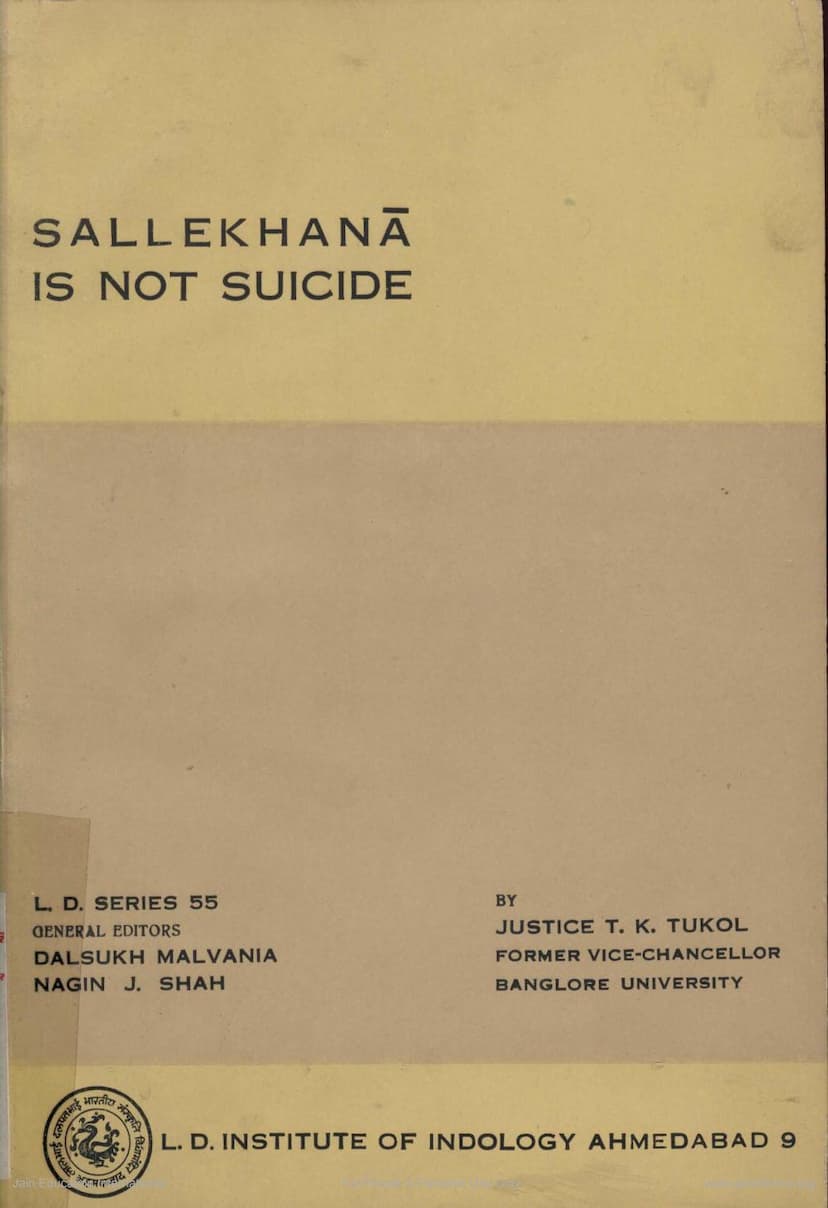Sallekhana Is Not Suicide
Added to library: September 2, 2025

Summary
Here's a comprehensive summary of "Sallekhana is Not Suicide" by Justice T. K. Tukol:
Overall Argument:
The book, "Sallekhana is Not Suicide," by Justice T. K. Tukol, argues forcefully and with extensive evidence that Sallekhana, a practice within Jainism involving voluntary, gradual fasting and meditation leading to death, is fundamentally different from suicide. Tukol contends that suicide is an act born of despair, mental imbalance, and worldly motivations, while Sallekhana is a deliberate, spiritually motivated process undertaken with equanimity, detachment, and the ultimate goal of liberation from the cycle of rebirth.
Key Themes and Arguments:
-
Philosophical Foundation of Jainism: The book begins by outlining the core principles of Jainism, including the substance-based metaphysics (Jiva and Ajiva), the concept of karma as the cause of bondage, and the ultimate goal of moksha (liberation). It emphasizes that spiritual progress in Jainism involves the gradual shedding of karmic matter through ethical conduct, austerities, and meditation.
-
Defining Sallekhana: Tukol defines Sallekhana as "facing death (by an ascetic or a house-holder) voluntarily when he is nearing his end and when normal life according to religion is not possible due to old age, incurable disease, severe famine etc. after subjugation of all passions and abandonment of all worldly attachments, by observance of austerities gradually abstaining from food and water, and by simultaneous meditation on the real nature of the Self until the soul parts from the body." This definition highlights the voluntary, gradual, passionless, and spiritually motivated nature of the practice.
-
Sallekhana in Practice (Historical Evidence):
- Inscriptions: A significant portion of the book is dedicated to presenting extensive evidence from Jain inscriptions, particularly from Sravana Belgola and other sites in Karnataka, dating back over two thousand years. These inscriptions detail numerous instances of monks, nuns, and lay followers (both men and women) who voluntarily embraced Sallekhana. The detailed accounts include their backgrounds, the circumstances leading them to the vow, the duration of their fasting, and their serene departure.
- Key Figures: The book cites examples like Bhadrabahu and Chandragupta Maurya, along with many other revered Jain ascetics and lay devotees, who are recorded to have practiced Sallekhana.
- Modern Examples: The book also touches upon modern instances, such as that of Acharya Shantishagar, to illustrate the continued practice and its spiritual significance.
-
Voluntary Deaths in Other Religions: Tukol explores similar practices of voluntary death in other religious traditions, including Hinduism (Mahaprasthana, Sati, Jauhar) and Buddhism. He notes that while some religions allowed or even glorified certain forms of voluntary death under specific religious or patriotic motivations, these often differed in their underlying philosophy and methodology from Sallekhana. He also highlights that Islam and Christianity generally condemn voluntary death.
-
Defining Suicide: The book contrasts Sallekhana with suicide by defining suicide as an act of self-destruction stemming from mental weakness, emotional distress, frustration, despair, or worldly failures. It enumerates various psychological and physical features of individuals who commit suicide, emphasizing the presence of negative emotions like fear, anger, shame, and hopelessness, and the use of violent or abrupt means.
-
The Law and Suicide: Tukol surveys the legal perspective on suicide across different countries and historical periods. He notes that while many legal systems criminalized suicide, the understanding and application of the law have evolved, with many jurisdictions now decriminalizing attempts or treating them as a matter for medical intervention rather than punishment. He emphasizes that legal frameworks are influenced by societal morality and changing norms.
-
Distinguishing Features of Sallekhana vs. Suicide: This is the core of the book's argument. Tukol systematically contrasts Sallekhana with suicide based on:
- Intention: Suicide is driven by negative worldly motivations (escape, despair); Sallekhana is driven by positive spiritual aspirations (liberation, karmic purification).
- Situation: Suicide occurs during emotional crises or failures; Sallekhana is undertaken when normal religious life becomes impossible due to circumstances like old age, incurable illness, or severe famine, and only with the consent of a spiritual guide.
- Means: Suicide often involves violent, abrupt, and harmful methods; Sallekhana involves gradual, controlled fasting and meditation, minimizing harm to the body.
- Mental State: Suicide is characterized by emotional turmoil, fear, and desperation; Sallekhana is performed with equanimity, peace, detachment, and often joy.
- Consequences: Suicide often causes grief, guilt, and social stigma to survivors; Sallekhana is viewed as a triumphant spiritual achievement that inspires reverence and devotion.
- Societal View: Societies often condemn suicide, while historically, Jainism and its followers have venerated those who practiced Sallekhana.
-
Critique of Western Interpretations: Tukol addresses and refutes interpretations by some Western scholars and observers who have mischaracterized Sallekhana as merely a form of religiously motivated suicide or starvation. He argues that these interpretations fail to grasp the profound spiritual, ethical, and philosophical underpinnings of the practice, especially its emphasis on detachment, non-violence, and the liberation of the soul.
-
Constitutional Rights: The book concludes by asserting that the practice of Sallekhana, being a deeply ingrained religious tenet of Jainism, is protected under the fundamental right to freedom of religion guaranteed by the Indian Constitution, and that such practices do not interfere with public order, health, or morality.
In essence, "Sallekhana is Not Suicide" is a scholarly defense and explanation of a central Jain practice. It utilizes historical evidence, philosophical exposition, and legal analysis to distinguish Sallekhana from suicide, asserting its spiritual sanctity and its positive role in the Jain path to liberation.